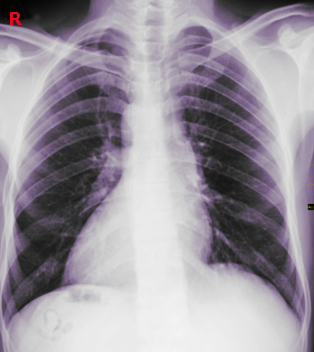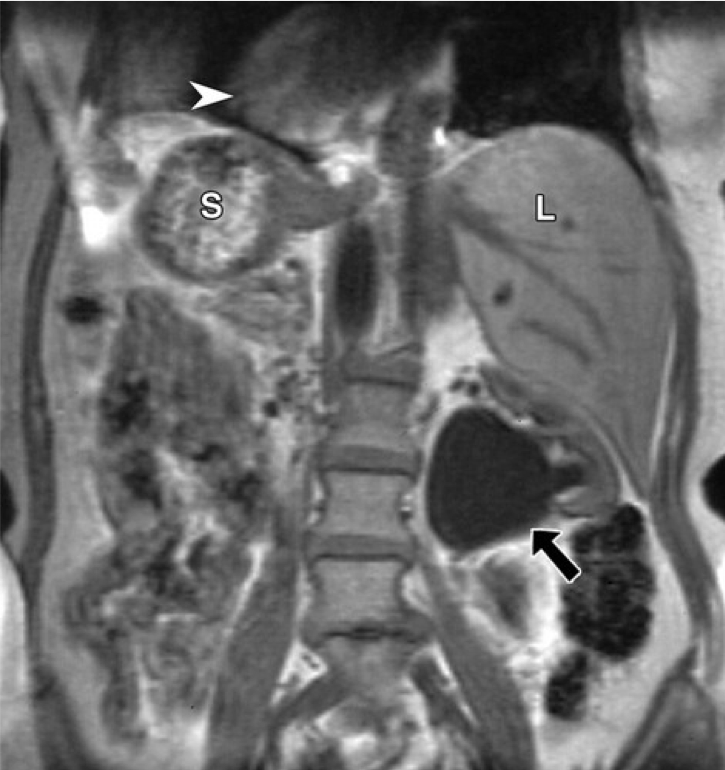[1]
Channabasappa SM, Mohan HS, Sarma J. A patient with situs inversus totalis presenting for emergency laparoscopic appendectomy: Consideration for safe anesthetic management. Anesthesia, essays and researches. 2013 Jan-Apr:7(1):127-9. doi: 10.4103/0259-1162.114019. Epub
[PubMed PMID: 25885734]
[3]
Leung AK, Robson WL. Dextrocardia with situs [corrected] solitus. CMAJ : Canadian Medical Association journal = journal de l'Association medicale canadienne. 2006 Aug 1:175(3):244
[PubMed PMID: 16880440]
[4]
Queiroz RM, Filho FB. Kartagener's syndrome. The Pan African medical journal. 2018:29():160. doi: 10.11604/pamj.2018.29.160.14927. Epub 2018 Mar 19
[PubMed PMID: 30050624]
[5]
Kim SJ. Heterotaxy syndrome. Korean circulation journal. 2011 May:41(5):227-32. doi: 10.4070/kcj.2011.41.5.227. Epub 2011 May 31
[PubMed PMID: 21731561]
[6]
Wolla CD, Hlavacek AM, Schoepf UJ, Bucher AM, Chowdhury S. Cardiovascular manifestations of heterotaxy and related situs abnormalities assessed with CT angiography. Journal of cardiovascular computed tomography. 2013 Nov-Dec:7(6):408-16. doi: 10.1016/j.jcct.2013.11.008. Epub 2013 Nov 7
[PubMed PMID: 24331937]
[7]
Bohun CM, Potts JE, Casey BM, Sandor GG. A population-based study of cardiac malformations and outcomes associated with dextrocardia. The American journal of cardiology. 2007 Jul 15:100(2):305-9
[PubMed PMID: 17631088]
Level 3 (low-level) evidence
[8]
Gupta S, Handa KK, Kasliwal RR, Bajpai P. A case of Kartagener's syndrome: Importance of early diagnosis and treatment. Indian journal of human genetics. 2012 May:18(2):263-7. doi: 10.4103/0971-6866.100787. Epub
[PubMed PMID: 23162311]
Level 3 (low-level) evidence
[9]
Kennedy MP, Omran H, Leigh MW, Dell S, Morgan L, Molina PL, Robinson BV, Minnix SL, Olbrich H, Severin T, Ahrens P, Lange L, Morillas HN, Noone PG, Zariwala MA, Knowles MR. Congenital heart disease and other heterotaxic defects in a large cohort of patients with primary ciliary dyskinesia. Circulation. 2007 Jun 5:115(22):2814-21
[PubMed PMID: 17515466]
[10]
Perloff JK. The cardiac malpositions. The American journal of cardiology. 2011 Nov 1:108(9):1352-61. doi: 10.1016/j.amjcard.2011.06.055. Epub 2011 Aug 20
[PubMed PMID: 21861958]
[11]
De la Cruz MV, Anselmi G, Munos-Castellanos L, Nadal-Ginard B, Munoz-Armas S. Systematization and embryological and anatomical study of mirror-image dextrocardias, dextroversions, and laevoversions. British heart journal. 1971 Nov:33(6):841-53
[PubMed PMID: 5120229]
[14]
Arunabha DC, Sumit RT, Sourin B, Sabyasachi C, Subhasis M. Kartagener's syndrome: a classical case. Ethiopian journal of health sciences. 2014 Oct:24(4):363-8
[PubMed PMID: 25489202]
Level 3 (low-level) evidence
[15]
Maldjian PD, Saric M. Approach to dextrocardia in adults: review. AJR. American journal of roentgenology. 2007 Jun:188(6 Suppl):S39-49; quiz S35-8
[PubMed PMID: 17515336]
[16]
Dilorenzo M, Weinstein S, Shenoy R. Tetralogy of fallot with dextrocardia and situs inversus in a 7-year-old boy. Texas Heart Institute journal. 2013:40(4):481-3
[PubMed PMID: 24082385]
[17]
Yusuf SW, Durand JB, Lenihan DJ, Swafford J. Dextrocardia: an incidental finding. Texas Heart Institute journal. 2009:36(4):358-9
[PubMed PMID: 19693317]
[18]
Huhta JC, Hagler DJ, Seward JB, Tajik AJ, Julsrud PR, Ritter DG. Two-dimensional echocardiographic assessment of dextrocardia: a segmental approach. The American journal of cardiology. 1982 Dec:50(6):1351-60
[PubMed PMID: 7148713]
[19]
Esmaeil H, Al-Fadhli J, Dashti A, Al-Sarraf N. Ischemic mitral regurgitation in a patient with dextrocardia and situs inversus totalis. Journal of surgical case reports. 2019 Nov:2019(11):rjz329. doi: 10.1093/jscr/rjz329. Epub 2019 Nov 20
[PubMed PMID: 31768245]
Level 3 (low-level) evidence
[21]
Ji YQ, Sun PW, Hu JX. Diagnosis and surgical treatment of congenital dextrocardia. Di 1 jun yi da xue xue bao = Academic journal of the first medical college of PLA. 2002 Jun:22(6):536-8
[PubMed PMID: 12297479]
[22]
NARA Y, ITOH T, KAMADA K, OHSAWA T, WADA J. A CASE OF INTERVENTRICULAR SEPTAL DEFECT WITH DEXTROCARDIA AND SITUS INVERSUS TREATED BY SURGERY. Japanese circulation journal. 1963 Sep:27():663-7
[PubMed PMID: 14045014]
Level 3 (low-level) evidence
[23]
Guo G, Yang L, Wu J, Sun L. Implantation of VVI pacemaker in a patient with dextrocardia, persistent left superior vena cava, and sick sinus syndrome: A case report. Medicine. 2017 Feb:96(5):e6028. doi: 10.1097/MD.0000000000006028. Epub
[PubMed PMID: 28151908]
Level 3 (low-level) evidence
[24]
. Prevention and therapy of bacterial infections for children with asplenia or hyposplenia. Paediatrics & child health. 1999 Sep:4(6):417-31
[PubMed PMID: 20212952]
[25]
Lin H, Cao Z, Zhao X, Ye Q. Left middle lobectomy for bronchiectasis in a patient with Kartagener syndrome: a case report. Journal of cardiothoracic surgery. 2016 Mar 9:11():37. doi: 10.1186/s13019-016-0426-y. Epub 2016 Mar 9
[PubMed PMID: 26960394]
Level 3 (low-level) evidence
[26]
Gupta R, Soni V, Valse PD, Goyal RB, Gupta AK, Mathur P. Neonatal intestinal obstruction associated with situs inversus totalis: two case reports and a review of the literature. Journal of medical case reports. 2017 Sep 18:11(1):264. doi: 10.1186/s13256-017-1423-z. Epub 2017 Sep 18
[PubMed PMID: 28918753]
Level 3 (low-level) evidence
[27]
Chang YL, Wei J, Chang CY, Chuang YC, Sue SH. Cardiac transplantation in situs inversus: two cases reports. Transplantation proceedings. 2008 Oct:40(8):2848-51. doi: 10.1016/j.transproceed.2008.07.115. Epub
[PubMed PMID: 18929882]
Level 3 (low-level) evidence


